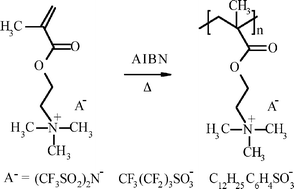The potential of using poly(ionic liquid)s as a new family of hydrorepellent materials has been explored. Free-radical polymerization of a series of ionic liquids based on the polymerizable cation [2-(methacryloyloxy)ethyl]trimethylammonium and on the hydrophobic anions bis(trifluoromethylsulfonyl)imide, nonafluoro-1-butanesulfonate and dodecylbenzenesulfonate led to the corresponding poly(ionic liquid)s that were characterized by TGA and DSC analysis, SEM, MALDI-TOF and XPS spectroscopy. Contact angle investigations show that the nature of the surface of the poly(ionic liquid)s based on the nonafluoro-1-butanesulfonate and dodecylbenzenesulfonate anions are featured by remarkable hydrophobic properties with advancing contact angles (θadv) lying in the range 113–118°, while to the polymer poly[2-(methacryloyloxy)ethyl]trimethylammonium bis(trifluoromethylsulfonyl)imide is associated poor hydrorepellent activity (θadv = 76°). The tensiometric measurements also experience receding contact angles (θrec) lying in the range 16–20° and a consequent high hysteresis suggesting that, on the outermost layers of the polymers, very high and very low-energy surface portions are present.

You have access to this article
 Please wait while we load your content...
Something went wrong. Try again?
Please wait while we load your content...
Something went wrong. Try again?


 Please wait while we load your content...
Please wait while we load your content...